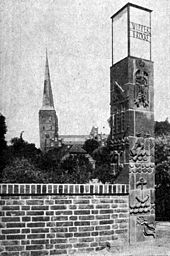Luffing bridge
Coordinates: 53 ° 51 ′ 30 ″ N , 10 ° 41 ′ 7 ″ E
| Luffing bridge | ||
|---|---|---|
| "New Wipper Bridge" in its original form | ||
| Convicted | Wallstrasse | |
| Subjugated | Trave | |
| place | Lübeck | |
| construction | Today's structure: Arch bridge. Earlier structures: Jochbrücken and drawbridge |
|
| completion | Drawbridge: 1644 Jochbrücke, 4 yokes: 1818 Jochbrücke, 4 yokes: 1880 Stone bridge: 1931 |
|
| location | ||
|
|
||
The Wipperbrücke is a bridge in Lübeck .
history
On Merian's view of the city from 1641, where the bridge stands today, you can see a wooden drawbridge over the waterway that connects the Trave with the Elbe-Lübeck Canal today . It should be seen as the ancestor of today's bridge. It served to connect the ramparts of the Lübeck bastionary fortifications , south of the old town , listed in the 17th century , with each other and with the city.
Only later, when the path behind the ramparts became a public road, did the Wipper Bridge play a role in traffic . Until 1938, the building divided the Wallstrasse leading over it into the II. Wallstrasse and III. Wallstrasse .
The French occupation troops severely damaged the Wipper Bridge shortly before their final withdrawal from Lübeck in December 1813 in order to make it difficult for the advancing opposing troops to pursue them. In 1818 a wooden yoke bridge was therefore built as a permanent structure.
In 1880 the yoke bridge was renewed and now only had two pile bays, a length of 21.15 meters and a deck width of 8.49 meters.
In the 1920s, Wallstrasse was designated as a relief and bypass road . At the end of the 1920s, the road was expanded and the load-bearing capacity and the load-bearing reliability fell from month to month. Ergo it had to be replaced by a “modern”, massive bridge.
At the same time as the bridge was built, an improved curve guidance of the streetcar was carried out, which was particularly necessary for high-speed traffic .
The new bridge
The "new Wipperbrücke" is a little north of the old wooden bridge. So it could continue to be used during the new building in 1931.
The opening of the “old bridge” for the ship passage was 6 meters. So only a boat could pass the bridge.
The arch of the new bridge with its 15 meters allows two boats to pass. The passage height of the new one has also been increased compared to the old one .
At 23 t for individual loads , its load-bearing capacity appeared to be able to meet the requirements of the traffic loads of that time and in the future .
The bridge is as concrete - girder bridge with cantilever been constructed ends. Of the two supports, one is designed as a concrete tipping bearing, the other as a concrete joint . Reinforced concrete - driven piles form the pillar foundations . The load-bearing parts are faced with brick .
The choice of building materials allowed the least amount of maintenance work.
The architectural design, a tight arch seems to be clamped between wing walls, was very simple.
The upper end line of the parapet wall shows a slight curve. The wing walls swing outwards at their free ends.
The only decoration on each of them was a lighting pillar , the surfaces of which were adorned with signs. The clay workpieces came from the Danish factory ceramics , where the sculptor Alwin Blaue created them as an original form for the fire.
The area was redesigned for the bridge. The relocation of the road required the deforestation of an old poplar on the eastern north side. The garden administration's work sheds at Mühlgraben had to be removed. The plans for the new building were drawn up by the building authority under the direction of the Neufeldt hydraulic engineering director . The foundation u. Concrete work was entrusted to the Lübeck company Ludwig Lange .
After the Second World War badly affected the bridge, neither the masonry parapet nor the pillars were rebuilt when it was restored.
swell
- Wilhelm Brehmer : Contributions to a building history of Lübeck - 5. The fortifications of Lübeck , in: Journal of the Association for Lübeck History and Antiquity , Volume 7, Issue 3. Edmund Schmersahl Nachf., Lübeck 1898
- Heinrich Christian Zietz: Views of the free Hanseatic city of Lübeck and its surroundings . Friedrich Wilmans Publishing House, Frankfurt am Main 1822
- Die neue Wipperbrücke , In: Vaterstädtische Blätter , year 1930/31, edition of August 14, 1931
Web links
Footnotes
- ↑ Since the bridge was very wobbly, in other words it wobbled, this gave the bridge its name.
- ↑ the model in artificial casting





